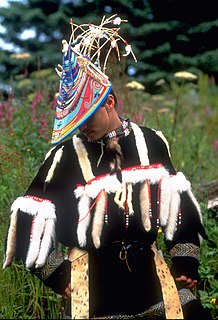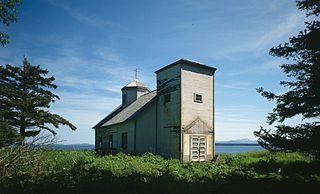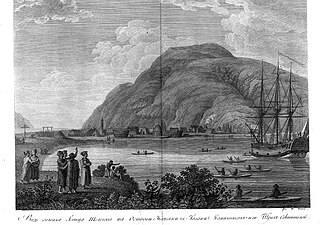
Aleneva is a census-designated place in the Kodiak Island Borough in the U.S. state of Alaska. As of the 2010 census, the population was 37, down from 68 in 2000.

The Alutiiq people, also called by their ancestral name Sugpiaq as well as Pacific Eskimo or Pacific Yupik, are a southern coastal people of Alaska Natives. They are not to be confused with the Aleuts, who live further to the southwest, including along the Aleutian Islands.

The Kodiak bear, also known as the Kodiak brown bear, sometimes the Alaskan brown bear, inhabits the islands of the Kodiak Archipelago in southwest Alaska. It is the largest recognized subspecies of brown bear, and one of the two largest bears alive today, the other being the polar bear.
The Alaska Native Regional Corporations were established in 1971 when the United States Congress passed the Alaska Native Claims Settlement Act (ANCSA) which settled land and financial claims made by the Alaska Natives and provided for the establishment of 13 regional corporations to administer those claims.

The Roosevelt elk, also known as Olympic elk, is the largest of the four surviving subspecies of elk in North America. They live in the rain forests of the Pacific Northwest and were introduced to Kodiak, Alaska's Afognak and Raspberry Islands in 1928. The desire to protect the elk was one of the primary forces behind the establishment of the Mount Olympus National Monument in 1909.
Sitkalidak Island is an island in the western Gulf of Alaska in the Kodiak Island Borough of the state of Alaska, United States. It lies just off the southeast shore of Kodiak Island, across the Sitkalidak Strait from the city of Old Harbor. The island has a land area of 300 square kilometers (120 sq mi) and no resident population.
Whale Island is an island of the Kodiak Archipelago in the Gulf of Alaska in Kodiak Island Borough, Alaska, United States. It lies off the northern end of Kodiak Island, between it and Afognak Island to the north. It is separated from Kodiak Island by Whale Pass, and from Afognak Island by Afognak Strait. Raspberry Island lies to the west, while Spruce Island lies to the east. Whale Island has a land area of 39.235 km² and is unpopulated.
Marmot Island is an island of the Kodiak Archipelago in the Gulf of Alaska in the U.S. state of Alaska. It is part of Kodiak Island Borough and lies east of Afognak Island. The island has a land area of 45.196 km² and is unpopulated.
Koniag, Incorporated is one of thirteen Alaska Native Regional Corporations created under the Alaska Native Claims Settlement Act of 1971 (ANCSA) in settlement of aboriginal land claims. Koniag, Inc. was incorporated in Alaska on June 23, 1972. Headquartered in Kodiak, Alaska, with additional offices in Anchorage, Koniag is a for-profit corporation with about 3,400 Alaska Native shareholders primarily of Alutiiq descent.
Phoenix was the first Russian-American Company ship built in Russian America. James George Shields, a British mariner in the employ of the Russian Navy, directed her construction, using mainly local materials. The boat was three-masted, 90 feet long, with a burthen of 180 tons (bm). The ship was named after the Phoenix, a trading vessel involved in the sea otter trade. In turn, she was the namesake of Phoenix Bay on Afognak Island. She was lost in a storm in 1799, a sinking that claimed the life of Joasaph Bolotov, first Bishop of Kodiak.

Raspberry Island is an island of the Kodiak Archipelago located in the Gulf of Alaska in the U.S. state of Alaska. It is located two miles northwest of Whale Island, and just across the mile-wide Raspberry Strait from the southwestern end of Afognak. The island is separated from Kodiak Island by the Kupreanof Strait, with the Shelikof Strait to the northwest. Raspberry Island is 18 miles (29 km) long with a width that varies from 3 miles (4.8 km) to 8 miles (12.9 km). The highest point on the island is 3,300 ft.
Shuyak Island is an island in the northern part of the Kodiak Archipelago in the state of Alaska, USA. It is located just north of Afognak Island, separated from it by the narrow Shuyak Strait. The Stevenson Entrance to Cook Inlet separates it from the Barren Islands further north in the archipelago. The island has an area of 168.3 km² and reported an official population of four persons at the 2000 census. Alaska's Shuyak Island State Park comprises most of the island's territory. The island's current major industry is tourism based on camping, recreational fishing, hunting, and kayaking. In the past the island was home to a large fish processing plant at Port William, but that industry has since declined with the advent of factory ships.
Port Wakefield is a ghost town in the U.S. state of Alaska. It is located on the northeast coast of Raspberry Island in the Kodiak Archipelago, along the western shores of the Gulf of Alaska.

Afognak Island State Park is a 75,047-acre (30,370 ha) Alaska state park on Afognak Island in Kodiak Island Borough, Alaska in the United States. Afognak Island is northeast of Kodiak Island on the Alaska Peninsula. Most of Afognak Island State Park is undeveloped. The park is known for its rugged topography and wide variety of wildlife. Afognak Island State Park is open to year-round recreation, including fishing, hunting, and hiking. Transportation is provided by float plane from Kodiak to various areas around the park. It is on the northern and eastern ends of the island and surrounds Perenosa, Seal and Tonki Bays. It borders part of Kodiak National Wildlife Refuge to the west.

The Nativity of Holy Theotokos Church is a historic Russian Orthodox church in Afognak, Alaska. The present church is the third Russian Orthodox church built in Afognak, and replaced the second which had been built in the late 1800s. Its construction began in 1901, and was completed in 1905. The community was mostly "washed out" by a 1964 tsunami, and moved to Port Lions, but the church building remained.

The Awa'uq Massacre or Refuge Rock Massacre, or the Wounded Knee of Alaska, was an attack and massacre by Russian fur trader Grigory Shelikhov and 130 Russian armed men and cannoneers of Shelikhov-Golikov Company against the Qik’rtarmiut Sugpiat tribe of Koniag Alutiiq (Sugpiaq) people of Kodiak Island in 1784 in Russian-controlled Alaska.

The Barren Islands are an archipelago in Alaska in the United States. They are the northernmost islands of the Kodiak Archipelago. The largest island of the group is Ushagat Island. The islands have a combined land area of 16.23 square miles and are uninhabited. The largest breeding grounds of seabirds in Alaska are located in the Barren Islands on East Amatuli Island and Nord Island. The archipelago is part of the Alaska Maritime National Wildlife Refuge.







